|

Emerging life from the winter forest floor.
(*photo
credit)
December 1, 2007 Christmas Card
Time?
I entitle this entry with a question mark because the
tradition of Christmas cards needs a fresh review with the postage
stamps now at forty-one cents and the cards themselves often over
a dollar each. Some of these are beautiful works of art and worthy
of being kept and framed. One of the great pains with cards is
throwing them away at the end of the season. Are there better ways
to express the spirit of the season?
First, consider those recipients who need the joy that comes
from a beautiful card. Christmas cards certainly serve a purpose
to tell the sick we care, to say we are aware of the ones who think
themselves forgotten, for very close relatives and friends who
expect cards, for those who have just had a severe loss this past
year, and for the faithful worker who needs the extra boost. I
must confess that those printed cards with printed names appear to
be somewhat of a waste of resources, but at least we are on their
list. The once a year missive with the nice little attached note
does touch our calloused hearts. Even the attached sheet telling
the comings and goings of a family makes the reader feel he or she
knows what is happening at least with respect to that distant
family -- weddings, vacations, sicknesses, garden produce and all.
There is still something touching about this effort on the part of
those close but not close enough.
And then there is the very special joy of the hand-made cards
or the special poem. Something extra went into this mailing that
makes it all the more delightful. It is certainly more than the
electronic mailing for one can hang them up or set them in the
special place to become the centerpiece of holiday decoration.
Card alternatives include the less energy-consuming e-mail
that could add a cheerful note to the season. The phone call could
be just what the doctor ordered at a particular time, as could the
homemade Christmas gift that truly shows another cares. Or maybe
it is the personal visit that means so much to the lonely; it is
the greeting across the fence or street or just down the road. All
have their place as the Spirit moves us to act.
Let's ask again, Christmas cards? At the beginning of this
month they seem to be such a chore if addressed at one special
time; but there is some worth to the good ones. Some of us tend
to save them because they remind us of the last sending by one who
passes on to the Lord -- and they often are works of art. Looked at
that way, they are part of the season and a tradition worth
continuing for we do not have that many good traditions. The
Christmas card is a great addition to civilization, and the ones
who send them seem to want to share the season's spirit with
others. Let them do just that and hope the spirit continues
throughout the year. Some resources are worth expending; some
costs are worth bearing; some time is worth giving -- and
Christmas cards may fit that category.
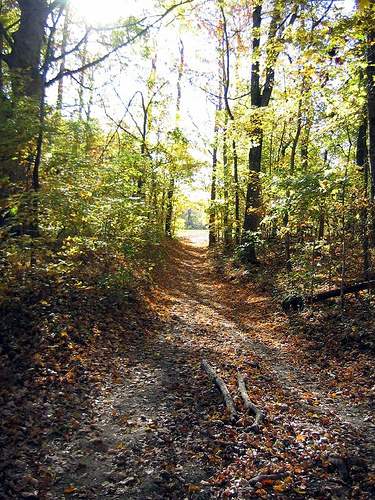
A view along the Natchez Trace, Tennessee.
(*photo
credit)
December 2, 2007 Vigilance and Earthhealing
You know the time; it is the hour now for you to awake from
sleep. (Romans 13:11)
Today we begin a new liturgical year, and new beginnings are
times for fresh starts. Awake! Paul's message hits us hard. Let
us awake from our slumber and start to heal our troubled Earth. It
is not enough to expose the troubles; we must act. We often cite
those who stand guard over their charges with great care like
llamas watching the livestock herd or the military guard watching
over the armed camp. Staying awake is easier said than done. It
takes effort and attention and full use of our senses. Vigilance
is intense and takes an effort because any human being is somewhat
limited in what can be done. Being awake throughout requires a
certain pacing and honing of resources in order to succeed.
Our vigilance needs to be focused for the time is short, the
critical condition of this troubled Earth is growing more severe,
and the resources to take corrective measures are limited. We do
not have the leisure that would come in less troubled times.
Stewardship of resources calls for cutting away that which diverts
our attention especially from any form of selfishness and self-
centeredness. Earthhealing involves us all and all that we can
give. Distractions hurt this effort and make us poor examples for
others who are asked to give their all as well. In the first
reading today we see that unfortunately the people in Noah's time
went about their daily duties without regard to what was happening
all around them -- a coming flood. We need to stay focused.
Our vigilance needs to be cooperative because of the
complexity of a work far beyond what we can complete as
individuals. All of us are limited in courage and energy and need
to take breaks for the catnaps that refresh us, for we are human.
Cooperative ventures like earthhealing practices cannot succeed
without teamwork. Thus we have to develop interactive skills to
help keep the team together, and involved.
Our vigilance needs to be public. It is not enough that we
retreat to hidden places of prayer and become entangled in personal
devotions that are divorced from the concerns of the entire world.
Others must see the motivation that inspires us and be caught up in
a similar attitude.
Finally, our vigilance may be counter-cultural. It is not
necessary that it be such, but it will surely become such if we are
in a culture that is more involved with distractions and false
allurements. If we bother people, they may become angry with us.
And their anger will make us disliked and even renounced. They
will seek to attack the messenger because the message of resource
conservation seems way too harsh. The flood of climate-changing
conditions will come upon us if we do not focus, work together,
proclaim the word in public, and are not willing to act with
courage.

A delicate assemblage of lichens
(*photo
by: Sally Ramsdell)
December 3, 2007 Rabbits
A few years back while on sabbatical in North Carolina I saw
the same small rabbit each day. I knew it was dangerously close to
where I was trying to grow a garden and wondered whether I should
kill it or not. However, we developed a friendly relationship and
it pleased me to see this almost tame rabbit each morning -- and
the place was designated a wildlife sanctuary. Furthermore this
rabbit had a great variety of vegetation to choose from and did not
need to feast on my garden. By happy coincidence I found that by
planting spicy mustard around the more accessible sides of the
garden plot I could protect the interior plants (beans, peas,
greens and carrots that rabbits tend to eat).
Some prefer to think of rabbits at Eastertime and that is
fine, but I always think of rabbits in late autumn for that is the
start of rabbit hunting season. I only hunted rabbit once, with
some friends, and resolved never again, for the rabbit was not
aggressive and never hurt any of us -- and what fun is there in
hunting down an innocent creature? Perhaps the only thing less
glamorous is dove hunting -- and that is simply impossible for a
peaceable person. At least a rabbit can be cooked into sour rabbit
stew or hasenpfeffer, which takes time and skill if it is to
be
done just right. We always had difficulty eating my brothers semi-
pet rabbits that were then butchered; raising rabbits makes
hunting or eating rabbit for meat only one step above eating pets
such as dog or cat.
Our most common rabbit in this part of the world is the
"cottontail" (genus Sylvilagus), which just about everyone
can
identify and most especially young kids are drawn to like and seek
to pet. These animals bound about in a playful mood and add to the
wildlife complexion of the countryside. They give a place a
special character. The generally larger house rabbit (white or
black) is affectionate and cuddly and makes a suitable companion --
though they require care in keeping cages clean and aroma-free.
Granted, the rabbit can become quite prolific in certain parts
of the world such as in Australia where there are no natural
predators. Here we eradicated the top feeders until the coyote
crossed the Mississippi to fill the niche left by fox and wolf; at
least carnivores hold the rabbit population in bay. But rabbits
can consume valuable crops and gardens. A rabbit enters the area
by hopping, but then surveys the immediate area by crawling and
moving its head from side to side; when confronting a plant like
the spicy mustard, instead of bounding over this barrier, the
rabbit is diverted to other vegetation closer at hand. Spraying
plants with a pepper mix will also turn the rabbit away. Rabbits
do not have the tenaciousness of the garden-eating groundhog or
raccoon so we ought to tolerate the rabbit in our backyard.
Rabbits can have a life span of from four to twenty years,
but certainly not a life expectancy of more than a few months,
since most are killed quite early in life from a variety of causes.
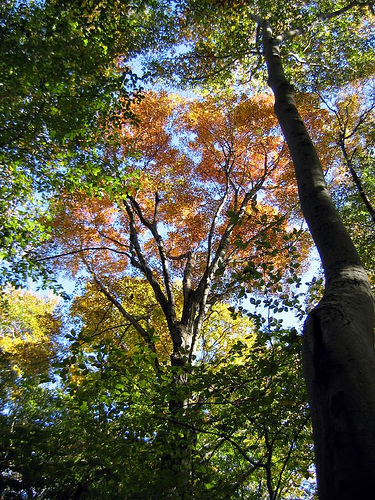
A burst of late autumn color in the forest
(*photo
credit)
December 4, 2007 The Poor: Problem or Solution
We are all God's children. So often an affluent well-
intentioned individual will look upon the poor folks around them
and regard them as "problems;" these demand charity and do little
in response; they are discontented because they do not have what
the affluent have; they are sources of violence, terrorism and
rebellion; they suffer from maladies and require healing. The poor
regard charity as a duty that does not require any thanks.
We are all God's children. So often a destitute person looks
upon the wealthy as stealers of what should belong to all the
people. These thieves strive to legitimize their holdings and even
undertake repressive measures in order to retain the status quo.
In democratic countries, the destitute strive for voice but find
little, and that increases their frustration and agitation. Only
the lucky few can escape the chains of poverty and receive the so-
called freedom of the affluent.
As God's children we are all part of a family that can be
regarded as dysfunctional -- and we have to accept this as part of
the human condition. However this dysfunctionality is shared among
all levels of income and social status; it embraces all of us, for
there is something wrong with inaction and over-reaction;, with
violence and allowing violence, with destitution and
superabundance. Thus we seek a third way, a family way to settle
difficulties. Our basic insight as Christians and even more as
Catholic Christians is not that we have the specific solution here
and now, but that we are one family and we must find a solution
together. With God's help we can find it if we have faith that a
solution is possible.
This brings us to the paradigm shift (change of our way of
thinking on this issue) required today. The affluent, the wealthy,
the formally educated do not have ready made answers. Some who are
well endowed are blinded into thinking that a "trickle down
charity" is enough. In their view the destitute, who lack basics,
do not have long-term answers because they are in need of being fed
and housed right now. But the poor hold a key -- that they are
equal partners and that clarity of insight in the way one reaches
a solution to the world's problems must include dealing with their
basic concerns: nourishing food, affordable housing, adequate
health care, quality education. To reach such a basic equilibrium
among all requires a radical sharing of the world's resources.
This social justice balance has a number of benefits: it
reduces insecurity and tension among various groups of people and
gives the precious time to rebuild a social order that is needed to
heal our troubled planet. The key to initiating the transformation
is recognition of the poor as valuable resources for change, not
grateful recipients of the largess of the affluent. If we think of
the poor (or rich) as a singular problem apart from the other
group, we need to change our thinking. We are one family and we
must treat each other as fellow family members. area.

Lycoperdon pyriforme, fungus on logs
(*photo
credit)
December 5, 2007 Off-setting:
Modern Snake Oil Sales?
A new industry is emerging in our world. It has hit the United
Kingdom and Europe and is heading westward to the United States --
the great frontier of commercial "off-setting." These are emerging
firms who prey on guilt feelings about jet setting for vacations
and other such extravagances; the profit seekers offer ways to
salve one's conscience by paying extra for a plane ticket. The
money is shunted to Africa to help make more efficient stoves for
the poor and thus compensate for the extra carbon dioxide generated
by the trip. The BBC had a special broadcast (September 20th) that
was critical of such operations -- and rightly so. We have already
reflected on the so-called neutral carbon theories (9/28/07) and
this seems to be still more of the same -- ways that allow a
continued practice.
The example used was that of a trip from London to Berlin and
back, over by plane (0.22 tons of CO2) and back by train
(0.10
tons), and the difference being the "off-set" calculated to have
someone else reduce emissions. The idea seems simple enough but
opens the door to a host of snake oil salespersons -- and they are
coming. The proponents of off-setting say it is a teaching tool for
raising awareness of how much greenhouse emissions are released in
a single practice that we undergo. All well and good if the lesson
is really learned, but off-setting may be a reenforcement of the
privileged position of those rich enough to expend in wasteful
ways. Some liken this to the misunderstood controversy over
medieval "indulgences" as permission to sin (never taught as such).
What is here is the offset as a guilt salving device to permit what
through self-denial should never have occurred in the first place.
Opponents point out that it permits the carrying on of a bad
practice or extended wasteful behavior as though the offsetting
really works. Does the alternative really do what it is slated to
do. Thus off-set proponents are looking for United Nations
regulations to certify certain schemes. Another equally poignant
point besides wasteful behavior is the encouragement of more
consumption. For example, the off-set pays for a wind generator in
a village in India. Now the villagers watch television and one of
the viewers decides to buy an advertised motorized vehicle that is
not really needed. In a few years the village has increased non-
renewable energy use while engaged in the benefits of the renewable
source, but this secondary effect is never considered in the off-
set calculations.
We need to take a serious look at this off-setting practice -
- this fad. Promoters of off-setting are more to blame than the
game itself, for these may be snake oil salesmen. They know the
added alcohol will soothe their patients to some degree but they do
not really attack the victim's health problem. We must expose
wasteful practices. Offsetting with its in-built commission
soothes the addicted consumer but does not address the addictive
behavior. Offsetting is a disservice to conservation programs.

View from Houghton across bridge to Hancock, Michigan
(*photo
credit)
December 6, 2007 Charity and the Christmas Spirit
If anyone is unwilling to work, neither should that one eat.
(II Thessalonians 3:10)
The feast of St. Nicholas comes
long enough before our
celebration of Christmas to allow us to reflect on how much and to
whom we should give charity. We have reflected in the past on the
concept of justice and charity and still consider that at times,
especially in this season, we should be selling scout cookies or
throwing money into the charity kettle. However, should we examine
this issue more deeply, for all who receive charity and do not
deserve it damage authentic giving by corrupting the beggar and
discouraging the giver?
I should certainly give (and have in the past) when someone is
apparently in real need -- someone stranded in the rain and needing
a ride, someone who needs a coat in winter. We recognize immediate
need and the decision to help comes more easily. When seeing that
someone is drunk or on drugs. We may withhold the charity out of
love for the betterment of the person who may need help but not a
monetary handout. Between cases of real immediate need and longer
term need come a host of other cases where a persons with
experience or spiritual insight will know that this case is
sophisticated "panhandling." Many of us do not have the experience
or have that soft heart that ignores the need for proper experience
to deal with such situations.
During this season of giving the following simple rules are
for me, both at my residence and when away, and for other readers:
* Size up the situation as fast as possible and try to give in
kind (food, clothing, vouchers, etc.) as opposed to money, which
could be used for the wrong cause.
* Ask pertinent questions as to the condition of the person.
So often the little time will allow you to make a better decision.
* Take time to get the person the ticket for the trip that is
needed in contrast to giving money on request to buy a ticket.
* Make known to the beggar the community agency that is
better suited to evaluate the request.
One of the best reasons for ensuring that the recipient is a
person in real need is that if you or a close friend gets fleeced,
both of you become hardened to giving -- and that is not the way
the world should be. It is quite true that those in clerical
attire are the target of many panhandlers, and this can make
walking down an unfamiliar street a trying exercise. A number of
times each of us, no matter who, will be approached and it is
embarrassing, for we need to move on -- and yet we are blocked.
Sometimes we give to the wrong cause just to avoid taking too much
time -- and some beggars know this. Let us not lose a generous
heart. It is okay to be too generous at times, but we have to
remember that our society is sated by material things and some
"charity" just deepens the desire for more goods. An extra point
worth considering is that justice should get primary focus, not
these handouts called "charity." I hope St. Nicholas would agree.

Backyard habitat: Unidentified mushrooms
(*photo
credit)
December 7, 2007 Looking Again at Fire Safety
Stand back or you might get burned. Don't hold lit candle too
close or place them on the Christmas tree. Don't play with
matches. Don't build a mansion in the middle of a forest filled
with accumulated thatch. These rather hackneyed warnings tell us
that we are all afraid of uncontrolled fires and seek to prevent
them. However, lit candles are mesmerizing; people like to stand
close to the fireplace; kids love to strike matches and make fire;
at least a million American homes are located in woods precisely
where they can easily be destroyed by forest fires. Oh, the fire
fighters will defend our place should lightning strike or an
arsonist start something on our hillside. Besides the homes are
generally expensive enough for fire fighters to brave the elements
and save the mistakenly situated structures.
We talk often about controlling smoking practices, checking
chimneys, being careful during cooking, refraining from certain
decorative lighting, not using malfunctioning electrical devices,
and composting and not burning discarded materials. All good and
well, but let's take a longer range view of fire and see the
respect we have for its power and unpredictability. Fire was what
we human beings first conquered for space and water heating, for
cooking, for light and for making and fashioning metal from ore.
Fire became the first spark of civilization and has been the human
companion down through the millennia. Fire deserves our deepest
respect for its power and benefits and its ease at getting out of
control when we least expect it to happen.
Human beings have felt empowered with fire when cooking and
smelting turned to execution with fire or inventing fire bombs and
fire storms that ruined cities and the lives of tens of thousands
in the past century. Fire is our promise and our peril and that is
what makes us all the more cautious and makes us talk about safety
to youth and elders alike. Our empowerment extends in harsh
fashion to the fire power of more and more weaponry used in twenty-
first century conflicts as well as to controlled burns of
combustible forests. Fires can be cleansing; fires can be
unpredictable; fires can be necessary; and all too often fire can
have unexpected and deadly consequences. Thus we respect the power
of fire even when we are empowered through fire.
And speaking of fire we approach the divine. Christ is the
light of the world, and light is associated with fire. Divinity
and fire are somehow seen together even though often misconstrued.
We light the new Fire each Easter but it is certainly not almighty;
we do the lighting and we become the guardians of fire. And along
with fire comes our sense of that distant moment in the dawn of
historic time when our ancestors first attempted to conquer and use
fire. Fire Safety Day impresses on us our God-given responsibility
to control fire and use it well. The reverence we seek in this
holy season is to be extended to include fire safety, for what we
fail to respect we can easily misuse -- and we could get burnt
through our disrespect of the gift of fire.
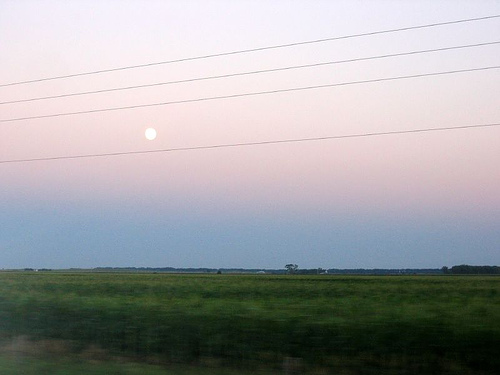
Evening sky at Fort Kearney, Nebraska
(*photo
credit)
December 8, 2007 America's Saint Names
Today we celebrate the Virgin Mary as patroness of our fair
land under the title of the "Immaculate Conception." Our mind is
turned to the saints whose names crop up throughout the United
States. For more serious themes on December 8 see the reflections
written in 2004, 2005, and 2006.
There are many place names of saints throughout the Western
Hemisphere, in Latin American and in Canada with its many Quebec
and Maritime Province contributions. However, the United States
has its share as well. The largest contribution is from our
largest populated state California. The Franciscan and other
missionaries of the eighteenth century "besainted" many places that
became large cities (San Francisco, San Diego, San Jose, and many
others besides Los Angeles, which could also qualify). And this
does not include the counties (Santa Clara, San Bernardino, San
Benito, San Joaquin, San Mateo, Santa Barbara, San Luis Obispo).
Besides California the plethora of town and county names
continues in all parts of the country with a heavy emphasis in the
southwest in former Mexican territory (San Antonio, San Angela) --
as well as the Hispanic influence in Florida (St. Augustine, St.
Petersburg, St. Lucie County). The second area is the great
Midwest (St. Louis, St. Paul and St. Cloud, Minnesota, and St.
Charles in Illinois and Missouri) with its French influence that
extended to Louisiana and the Mississippi delta (St. James and St.
Helena parishes and Bay St. Louis in Mississippi). Another area
near Quebec, Maine, Vermont and New York, has respectively St.
Francis, St. Albans and St. Regis. That brings us to a third layer
of saints' names that are surprisingly found in the southeast and
in various scattered states (St. Paul in Virginia and North
Carolina and St. Georges in Delaware), which are partly of Anglican
origin. Midwestern names are associated with missionary activity
among the Native Americans (St. Ignatius, Montana, St.Francis in
South Dakota and St. Stephens, Wyoming). Some are from small
settlements of generally Catholic Germans and others (St. Donatus,
Iowa, St. Wendel and St. Meinrad, Indiana, and St. Croix and St.
Nazianz, Wisconsin).
The most popular saint is to be expected on this Marian feast
day: St. Mary's appears in a number of states including Maryland,
Kentucky, Ohio, and Georgia. In fact, some forty-four states have
saint place names (a majority are cities, towns and even
unincorporated villages, two dozen are counties, and one in Nevada
is a mountain range. A search of state maps, Google and post
office searches cannot uncover saint names in six states. Hawaii
has many native named places. Interestingly enough some of the
most heavily Catholic states (Rhode Island, Massachusetts,
Connecticut, New Hampshire and New Jersey) have no saint names,
This is due to their being settled by Puritans and other
Protestants in the seventeenth centuries when much of the first
naming occurred. Should a possible saint named place be found in
any of these six states please notify this website.

A look of gratitude after receiving a hand-full of grass from
the other side of the fence.
(*photo
credit)
December 9, 2007 Repentance
Repent for the kingdom of heaven is at hand. (Matthew 3:1)
How dare you talk about repentance! Don't you know that this
is old-fashioned and not our way of modern thinking? This initial
reaction may be natural to people who like to hear soft, soothing
words, who hold privileged positions in use of resources, who like
to do whatever they wish, and who do not want others to dictate
anything to them.
Soothing words. Listen closely to the so-called religious
radio and television stations. When the message is one of pure
comfort, always sugary and devoid of self-denial, it is today's
equivalent of the false prophets of old. If hearers are caught up
in extravagance and wasteful practices, why bring up irritating
issues? These are hard on donations.
Privileged positions. Come to our senses! Who are the
privileged persons in a world of limited resources? Perhaps those
who use four, twenty, or one-hundred times what others in poorer
nations use. Privilege embraces billionaires, and it embraces all
who live the lifestyles of many Americans and Europeans as well.
Doing what one wishes. The last of the great prophets of
old, John the Baptist, preached reform needed in preparation for
Christ's coming. He tried to shake the people from their
individual practices. Today, the need is for plain-spoken people
to speak out against those who waste resources and seem to absolve
themselves by practicing off-setting (see December 5th), a hoax
that allows some to continue in their practices without being
challenged. Some landowners who know an endangered species is
present will deliberately go out when others are not looking and
destroy the habitat and kill the species, lest the land be declared
off limits to development and severe curbs be placed on what can be
done. This impulse to use up what may be restricted, bodes
destruction to threatened species -- and it is a product of doing
what one wants with what the person thinks belongs to him or her.
For such people the one who brings the warning needs to be
silenced. That is what also happened to the prophets of old.
Applications. Today we too are called to be plain-spoken; we
are to speak the truth that can sometimes be quite hard to accept.
To preach this brings about a risk of being ostracized and looked
down upon. The inhabitants of this troubled planet once again need
to hear the message to repent, to return to the Lord, to give up
wasteful practices; we need to be reminded to consume less
resources, cut our wastes, radically share with the poor, and
break the addictions of our people. We cannot do these things
alone or by merely mouthing them. The profound transformation
requires governmental regulations that include increased taxes and
penalties on the privileged; thus we can have a fair redistribution
of the wealth so that all can share the resources that rightly
belong to them also.
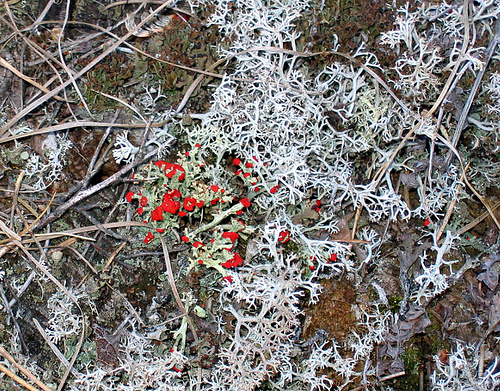
British soldier lichen, Cladonia cristatella
(*photo
credit)
December 10, 2007 Ecologically-Related Human Rights
On Human Rights Day we can emphasize the need for freedom of
speech, the press and worship, freedom of assembly and right to a
fair trial, and freedom from enslavement. Over the years a number
of rights have been enunciated that are being developed through
governmental interaction and policy-making at all levels. What
would be of interest is an emerging awareness of rights that deals
with ecological matters. I have a difficulty in assigning rights
language exclusively to animals and plants as though they exist
apart from us. The welfare of animal and plant communities affects
us all and so some of these "rights" include these beings but not
regard them as separate from us human beings. Thus all rights
dealing with the environment are also human rights. The following
are some of the ecologically-related human rights:
* The right to a good environment;
* The right to clean air on the part of all;
* The right to potable water on the part of all;
* The right to a safe habitat where life can prosper and be
secure, and here safety includes adequate and affordable housing;
* The right to life and the ability of the species to
continue in the community of all beings;
* The right to basic nourishment that is not held back in any
way by the extravagances of the overly wealthy and privileged.
* The right to express oneself in all matters dealing with
one's well-being and advancement.
* The right to basic travel, though restrictions can
be imposed for the good of the greater number.
* The right to basic information that may deal with the
health and safety of all.
* The right to resources that are sequestered by the
privileged few and used in a wasteful manner.
* The right to a fair exchange of the products of one's own
industry and endeavors.
Note: The so-called right to land is even more vague than the
above listing, for not all land is available to all people in some
possessive fashion. Much land must be held in common and regarded
as green space, thus not subject to individual possession and use.
The question arises as to what property belongs to whom, and land
is often at the heart of these controversies. Certainly small
tracts of land would be better held by individuals for growing
basic food for immediate use.
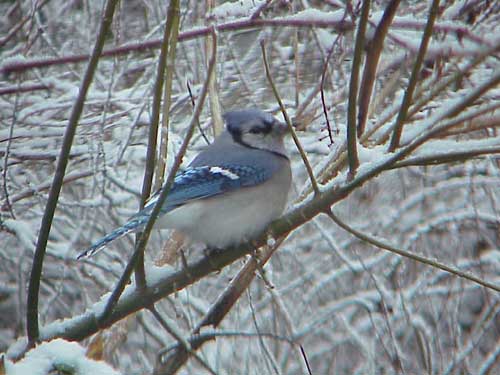
A blue jay (Cyanocitta
cristata) taking cover amidst snowy
branches, a lovely winter scene.
(*photo
credit)
December 11, 2007 Fear of the Lord: Preserving Reverence
This gift fills us with sovereign respect for God, and makes
us dread, above all things, to offend the divine majesty. Here awe
that has a sense of the wonder of mystery is mixed with fear. We
realize that our mission in life is awesome and we are also aware
of our own weaknesses in completing that mission. Piety elicits
enthusiasm but this is always overshadowed by a seriousness for the
work ahead and here the gift of fear of the Lord enters the
picture. The mission is not all fun and games, but rather involves
a deepening sense of respect for God and for those around us; we
show respect to God in formal prayer; we should respect others in
the manner in which we serve them.
Respectful relations, courtesy and proper manners may be more
a hope than a current reality. Examples from abrupt e-mails to
foul-sounding talk shows, from rude road rage to curt everyday
discussion make us wonder whether civility is eroding in our land.
Do we still respect -- our past, our family life, our neighbors,
our religious practice, our state and nation and the leaders, our
environment, the political process, commercial and professional
advice, and our elders and wise folks? Is it possible that we have
allowed the erosion of respect through silence when we should have
spoken, through our own haste and lack of manners, or through
pranks, jokes, back-biting, unresolved disputes and cynicism? Has
a past courteous respect wasted away, or was it ever there? Did it
erode imperceptibly through commercialism, wars, legalizing
abortion, crass exploitation of the land, and the ever expanding
gulf between the rich and poor? What about MTV, ready cash
through credit cards, talk about rights alone instead of rights and
responsibilities, and ease of access to unprocessed information?
Our respectful practices of the past may be mere romantic
hindsight. However, today we see clues of a lack of reverence for
life, for country, for leaders, or for church practice. "I am for
me" can play havoc to any common atmosphere of respect as, for
example, to pay respect to someone who is sick or to the bereaved,
to pause when the funeral passes, to welcome strangers into a
community, to offer a seat to an elderly person, or to send get
well cards. Does respect erode because of a decadence within our
culture -- the break down of marriage, family, and community? Is
there a championing of irreverence in Hollywood and the mass media,
in the manner one dresses for school or church, or how we greet
another person?
Application: Lack of general respect makes us search for a
return to reverence in all its forms -- to God, to people and to
Earth itself with its broken down communities and broken down
biosystems. Mountains are leveled, valleys filled, and the
vegetative cover stripped away to satisfy distant chipmills. If we
are persuaded to regard resources as worthless, then we are being
lulled into silence when exploitation occurs. We are soon left
powerless to change the tide of events. Regaining reverence
involves a fear of the Lord.

Mistletoe, Viscum album
(*photo by:
Dorocia - Creative Commons 2.0 attrib/share-alike)
December 12, 2007 Roses, Poinsettias, Mistletoe, and Evergreens
Earthhealing includes an interest in the flora and fauna of
the season. December has fewer choices than the spring and summer
months because this is not normally the growing season. We must
give a prominence to them for other reasons than that they bloom or
produce fruit in this month. Our focus is dictated by culture and
other reasons but we do have some floral candidates.
Roses -- In Washington, D.C., I once found a single surviving
rose blooming in December and (perhaps taking the liberty) I
plucked it and sent it to my mother. After her death we found this
"last rose of summer" in her Bible and it gave a certain
gratification. Today is our Lady of Guadalupe's feast and the
roses that fell from Juan Diego's cloak in December, 1531, were
certainly not flowers of the season -- and yet flowers of all
subsequent seasons. The rose could be the flower of spring or
summer or even autumn, but maybe it has a prominent place among the
flowers of the world and is best remembered in December when it
does not normally bloom.
Poinsettias -- This is also Poinsettia Day. During the
Christmas season in this hemisphere people purchase pots of
poinsettias to decorate homes, stores, offices, and church altars.
It has become a favorite with its beautiful red leaves that are
seen to stand out above other decorations. This is a Mexican and
Central American plant (Euphorbia pulcherrima) that is a member of
the spurge family, and the brilliant red leaves that surround the
yellow flower are considered as petals -- and certainly stand out.
Mistletoe -- The more English tradition of the season is to
decorate homes and arches with the parasitic plant, with the
yellow-green leaves and shiny white poisonous berries, growing on
trees. We would shoot down some mistletoe with a shot gun and use
it for general decorations -- and the youth were always allowed to
steal a kiss under the mistletoe.
Evergreens -- Maybe this is the month of all the evergreens of
the world -- and that is a large number. When the growing season
ends in the northern half of the globe, we search around for
decorations, green decorations. The poorer folks all turn to the
evergreens more frequently found where they are living. At home
when I was growing up, one Sunday of December was given to hiking
about the back fields in this limestone country where the "cedar"
(an American juniper) grew and selecting the sapling that was full
bodied and without blemish of any kind. This became our Christmas
tree.
---------------
Where we highlight particular plants or groups of flora, we
highlight the Creator of all things and show that we respect the
beauty and prominence of these creatures during this season.
Healing our Earth includes giving special attention to different
plants. We recognize them as gifts worth protecting and
celebrating in a special way during this special season.
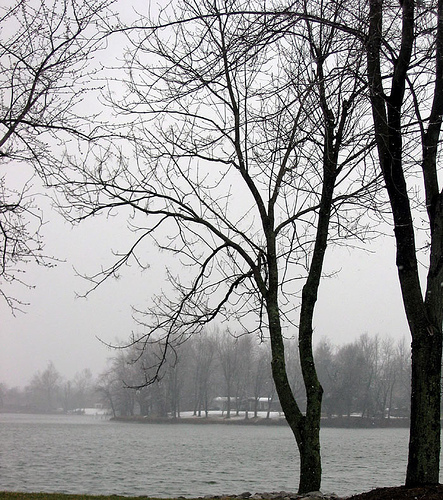
A snowy day, looking across Reservoir #3, Lexington, Kentucky
(*photo
credit)
December 13, 2007 Attributing the Driving Time
We have a car and will travel. Let's hope it is an energy
efficient one that we keep serviced in prime shape to save on fuel.
A person with personal use of a specific vehicle and lacking the
need to logging trips for some agency or superior will certainly be
less careful as to how much the vehicle is used. Someone who must
log trips as to mileage and purpose will treat travel time and
distance differently. In this age of global warming all of us who
are drivers wonder whether we can reduce the miles we travel by car
in one or more ways. If we bike or walk, the distance and time
factor need little or no listing, but the fuel burning vehicle
does. Is this trip necessary or not? Can it be combined with
another? Can it be replaced by communication through phone,
Internet or letter?
Planning. One way to drive less and more meaningfully is to
curb excessive driving through planning ahead. How do we combine
the necessary trips? If going to a town for some errand or during
our driving to or from work, can other things be done on the way to
or from the site? I have resolved to do grocery shopping and
visits to the hospital and communion calls on the way to or from
bi-weekly trips to the neighboring parish church. It is best to
anticipate what food is going to expire or when I will be heading
in the direction again so two trips can be combined into one.
Justification. All too often a meeting is in a distant place.
Merely driving or taking a plane is not an either/or option. One
periodical reported that larger commercial planes emit 0.06 tons of
carbon dioxide per hour per passenger. Is it true? Certainly if
someone takes his or her own private plane without passengers the
amount of fuel used is higher by several magnitudes. Whatever the
amount, it generally comes to more than the energy-efficient
passenger car traveling seven hours (400 miles) would use. The car
would burn 70 some pounds of hydrocarbon fuel and produce about 250
pounds or 0.12 tons of carbon dioxide. Much depends on the number
of passengers on a particular airplane flight and the fuel it takes
to perform private surface travel to and from both airports.
Necessary for whom? The third aspect is whether the trip had
to be made or was made for pleasure or for a particular service.
And is the purpose directed to the individual doing the driving
(medical trip, etc.) or to a clientele or individual other than the
traveler. If I travel to serve a community or church, does the
fuel I use get credited to my personal account or to the individual
or group whom I serve? You can hardly divide the fuel for an
aircraft carrier by the number of service personnel aboard; the
fuel is expended for those being defended in a nation or nations.
Dividing by the benefactor(s) makes the process of allocating fuel
expenditures far more complex. However, the complexity should not
totally stop us from our concern about non-renewable energy use.
We all ought to look into energy use and find ways to conserve and
do it now whether the travel is for ourselves or even for
unspecified "others."

Rural ruins near the Rockcastle-Pulaski County border, Kentucky
(*photo
credit)
December 14, 2007 Does It Really Matter? Earth Is Lost
This question sounds so innocent and yet is an example of the
despair experienced by some with the enterprise of Earthhealing.
The person may be more than someone who sees no future, no ultimate
outlet in life. He or she may be a believer (as is the case with
the one who raised this question and comment to me yesterday). He
testified that he believes in eternal life for himself, his family,
his friends, and all people -- and it is enough to struggle to gain
that alone. Why get further concerned about Earth itself? Let it
go, for Earth is doomed to eternal death in the natural course of
events; our efforts are of such little avail.
I confess that this question cannot always be satisfactorily
answered in a five hundred word reflection. One quick answer is
rather militaristic. You my friend, are ordered by the Almighty to
take care of all God's creation and "ours is not to reason why,
ours is but to do and die." That answer may not satisfy too many
and sounds too much like treadmill treading. Life must be more.
Another answer touches many who are compassionate: Jesus loves
all even little (overlooked) people as well as little animals and
plants. Shortness of life does not mean life is valueless. Rather
life has deep value for as long as it lasts -- even mortal life --;
and our concern and care show that we stand with the Lord on these
matters. Even those that have less than eternal life are worthy of
that love and concern -- and so everything we can do for them
matters a great deal. For we are the Lord's in all we do.
The third approach is inclusive, for Earth enters into our
glorification and eternal life -- the New Heaven and New Earth as
Scripture says. Just as the scars from the crucifixion are on the
resurrected Christ, so our resurrection to eternal life will
include glorified bodies with their scars. We are part of an Earth
and so our Earth is part of our eternal quest even in ways we do
not fully understand. If scars are eternal, so are the scars of an
Earth that we have hurt in some way -- and the marks of our
glorification of Earth are to be an eternal glory.
The last way to treat this despair is to be reflective
ourselves, for such questions are not so much answered quickly as
made the subject of reflection -- so that it is a lifetime of
reflection that is needed to discover an answer. Why feed the
hungry for they will die anyway? Why give the poor better housing,
for they will mess it up? Why should I have insurance or go to the
doctor or get my homestead fixed up, or just continue living? Why
do anything? Of course, part of the answer is that the affirmation
of life pertains to our eternal salvation, to all that we love and
seek to care for in some way. But our answer is our life, and we
help those who suffer from this false humility (or despair) by
reaffirming that our life is worth something, very much, and so is
theirs. Our confidence in their coming to a satisfying solution is
part of the answer. We need to have more faith to heal all things
even our troubled Earth.
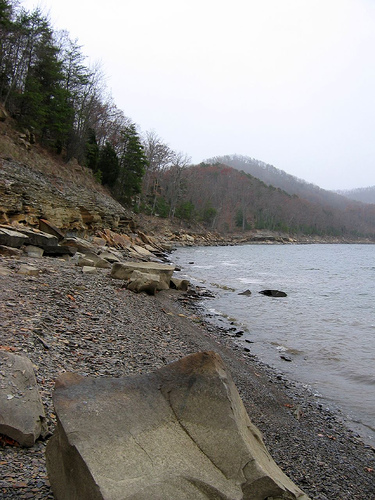
Cave Run Lake, near Morehead, KY
(*photo
credit)
December 15, 2007 Nine Ways to Make Winter Endurable
Winter is coming soon. The obvious winter preparations
include more home insulation, obtaining warmer clothing and
blankets, and storing food and goodies in case a winter storm
closes the roads. But after one of the hottest summers on record,
cold weather seems a welcome relief. Some people find the cold
less endurable than the heat of summer, but, as global warming
makes our winters milder, winter will likely be regarded as the
more endurable season. Here are some ways to guarantee this
season's rightful place:
* Resolve to read more books this winter and assemble a list.
Visit the bookstore and store up on reading material or trade books
with friends.
* Obtain a few movies to watch in stormy and icy weather.
These can ensure a virtual vacation without the hassle of air or
other forms of travel during the inclement season.
* Storms are memorable but the presence of extra frozen, dried
or canned food, just in case, could prove helpful to tide you over
without risking going to the grocery store. You may want to store
a few gallons of water should the supply be curtailed as well.
* Electricity flow may be interrupted during ice storms.
Obtain a supply of candles, matches, blankets, flash lights,
batteries, and a battery or hand-cranked radio for use to get news.
Yes, perhaps a cell phone could come in handy also. Note, the
photovoltaic solar panels are quite welcome when the utility
electricity fails.
* Develop a phone tree or a neighborhood notifying system just
in case the storm does come and others may be less aware of the
upcoming harsh conditions.
* Keep the space heating temperatures down to the lowest that
you can stand assuming that you will wear heavier clothing during
the day and night. Less flu and fewer colds occur when indoor
temperatures are kept lower. Besides, overheated houses are
uncomfortable when considering the heating bills.
* Plan fewer trips during the winter and see whether some
travel can be postponed to spring or summer. Winter or night
driving is difficult for many of us and this is the season for
critical planning.
* Do some garden-growing in a greenhouse, with plants brought
in during the winter, or through the use of seasonal extenders, if
you live in a more temperate location.
* Continue indoor exercise throughout the season (10/26/07).
There are times when it is unsafe or unhealthy to attempt outdoor
exercise.
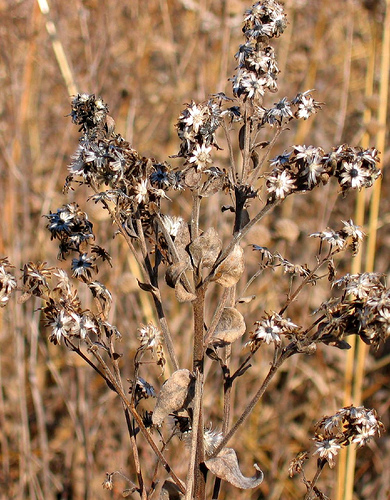
Standing stalk of dried flowers, left over from summer blooms
(*photo
credit)
December 16, 2007 Genuine Puzzlement
Are you the one who is to come or should we look for another?
(Matthew 11: 3)
John the Baptist is a good man, a person who lives most
simply, who speaks forthrightly, who is not arrogant, who trusts
that another is greater than himself, who defies authorities in the
manner in which he speaks, and who does not experience first hand
his cousin Jesus' ministries. The puzzlement comes through
distance and lack of that one-to-one manner through which Jesus
inspires the crowds that he personally contacts. Jesus eats and
drinks with the people whereas John abstains and fasts severely.
And both are subject to critics who find fault in either position.
Jesus sends back the message: the blind regain their sight, the
lame walk, lepers are cleansed, the deaf hear, the dead are raised,
and the poor have the Good News proclaimed to them.
Today in this age of false prophets we also experience genuine
puzzlement. The response to such questioning comes in the works of
the Messiah and what was of consideration in John's days also
applies today. The basic message of healing the Earth must be one
of appropriate technology, living simply, healing an Earth that has
been ruined and bringing that Earth back to life. To say that
deeds may be overlooked is erroneous. But the final proof is that
the Good News is proclaimed to the poor who benefit in hearing it.
Amazing deeds must be done for the destitute people who have their
own lives cut short by lack of the basics of life -- providing
food, medicine, adequate housing, and basic education.
The Good News is that attention must be given at last to the
poor. If these were given the basics and the privileged controlled
in their use of resources, justice could again occur on this
troubled planet. We bring Good News that curbing excesses and
halting the waste of resources that do not belong to the spenders
will allow for all to have a fair share in due time. The Good News
is that the poor have a right to be involved in deciding how those
resources are to be spent. They certainly do not have to wait
until the wealthy are wiling to share with them -- for their wait
will be forever. The Good News is that they are empowered through
the Baptism and Confirmation to help take what is rightly theirs,
not to ask for it but to be involved in taking provided it is done
without violence. If the privileged are willing to cooperate, they
are also moving in the right direction.
The Good News involves a caution. To take does not mean to
take violently, though drastic measures may be required as a last
resort to keep people alive who are threatened by the lack of basic
resources. The Good News is that taking what belongs to all should
be done in a non-violent and gentle manner with the cooperation of
all parties. If this ideal can be attained, the Kingdom of God
will be advanced. But this is not an Earth-shaking message, though
one that could be immensely beneficial to all inhabitants. This
too is an arena of puzzlement. Can this be done in this present
age or must we look for another way?
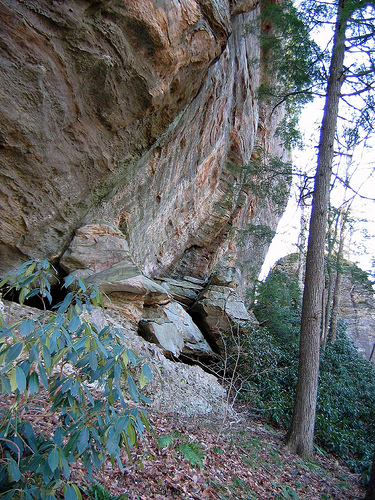
Point of contact: Sandstone over Limestone at Cascade Caverns
(*photo
credit)
December 17, 2007 Renewable America -- 2025
As the global climate change crisis mounts and policy makers
scramble to make plans for how they will become more renewable, it
is necessary that the United States, a consumer of five times the
resources of the average world citizen do the same. These plans
are now becoming a part of our national energy policy. Citizens in
this country agree at least in public with the need to conserve or
share resources, but are realizing that all of this takes effort on
the part of all.
We can develop new short-term bench marks and know full well
that they will not be met. At the moment of this initial draft
(three months ago) the mood was not one of conservation. In fact,
the national policy has been and seems to remain to consume to your
heart's content because tomorrow you are to die and can't take it
with you. As long as that policy endures, little conservation
occurs even when fuel becomes more and more expensive.
Since any plans must be both realistic and non-disruptive,
lest the citizens sacrifice the planet for their immediate
enjoyment, then we should discuss renewable energy measures that
are reasonable. We can speak more easily about a 2025 plan along
with a longer term carbon-free 2050 plan that calls for all non-
renewable energy sources being eliminated (even carbon dioxide-
emitting wood and other biofuels). So we propose here a plan for
the year 2025 that does not include undeveloped and untested
renewable energy measures; rather, the plan is focused only on
areas of known and operative renewable energy sources, namely,
hydropower, higher quality wind, higher quality solar, and
currently available geothermal methods along with current use of
wood and other biofuels except where food products are concerned,
the latter being intermediate fuel uses.
First, it is assumed that all states must adopt energy
conservation measures and these must be in force by 2025, or
better, ASAP. But to be realistic these conservation measures at
a national level will only hold current consumption in check, not
serve as a substitute for new electric generating facilities to
replace those being phased out. A second consideration is that the
transfer from non-renewable to renewable economies must proceed
faster in some states than in others, though all could be
attempting lower quality wind and solar implementation to some
degree. Our contention is that we cannot ask for uniform
participation by all states, for some have more available renewable
resources than others.
Note: This plan does not absolve wasteful practices in any
way. It is not the "off-set mentality," which permits current
practices to some while giving attention to alternatives. It
simply sets a forty or so year timetable with heaver emphasis on
states like the western ones for faster conversion to renewable
energy uses. Even here, some will feel either slighted or overly
designated, but ultimately Renewable America is the goal.
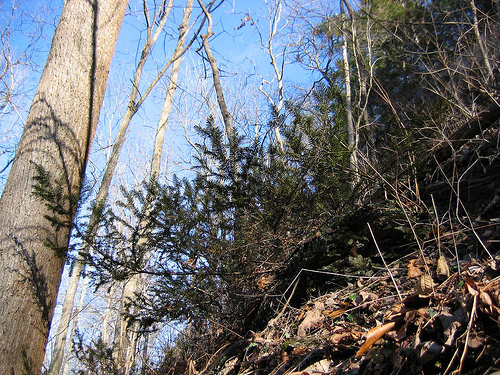
Taxus canadensis, uncommon in Kentucky
(*photo
credit)
December 18, 2007 Renewable America -- State-by-State
The first phase of renewable energy development includes
reasonable energy conservation measures that would hold energy use
steady while at the same time allow the phasing out of nuclear
power and outworn coal facilities as each reaches the retirement
age. The fraction of population in various states that is within
fifty miles of a high level wind, hydroelectric, geothermal or
solar power source or generator is the target of this first phase.
Wood is omitted because it is not carbon-free though still used in
this intermediate period in certain mostly rural areas of this
country. State-by-state estimates are as follows:
Hydropower --
Estimated total: 6 million
High Quality Windpower --
90% of CN, IA, KS, MA (Cape Cod off-shore facilities
included), NE, NH, NJ, ND, SD, WY 25 million
80% of CO, HI, NY (mostly northern highland areas along with
Long Island off-shore coast areas), OK, RI (off-
shore), SD, UT 28 million
60% of ID, MT, OR, WA 7 million
50% of DE (off-shore), IL, ME, MN, NV, WI 14 million
40% of TX western, central, Valley
and Dallas metro area 9 million
25% of CA (Northern portion of state) 10 million
20% of NM, OH (northeastern off-shore Lake
Erie), PA (western and northeastern but not
Philadelphia area) 5 million
10% of AK, AR, MD, MO, NC, TN, VA, WV 4 million
0 - 5% of AL, AZ, FL, GA, IN, KY,
LO, MI, MS, SC 1 million
----------------------
Estimated total: 103 million
Geothermal accessible --
(Based on U.S. EIA designated areas.)
Estimated total: 8 million
High Quality Solar --
(Based on U.S. EIA designated areas.)
Estimated total: 33 million
Grand total 150 million
This half of the total U.S. population is the primary target
of the phase one period (2008-25) in creating a Renewable America.
The whole nation must conserve resources ASAP. All states must
hold and/or reduce their energy use during the period so that more
powerplants will not be needed.
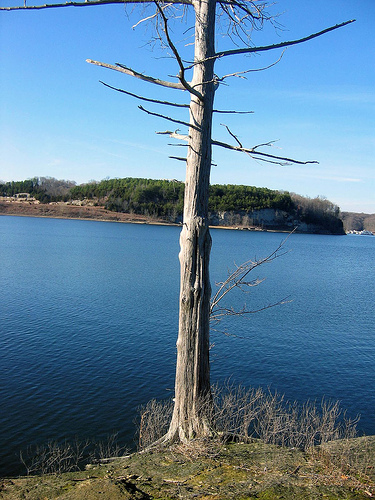
A lone tree along the Green River Lake, Kentucky
(*photo
credit)
December 19, 2007 Hydropower's Potential
The first renewable area is the first major renewable energy
source of the last two centuries -- hydropower. We have spoken of
in the past of macro, medium and micro hydropower potential,
remembering that flowing and falling water powered the nineteenth-
century beginnings of the American industrial revolution.
Hydropower was the first major source of electricity and in the
early 1900s accounted for 40% of the nation's supply of
electricity. In the 1940s three quarters of all the electricity
consumed in the West and Northwest came from hydropower. As demand
for electricity continued to increase after World War II, less and
less of the total was supplied by this renewable source. Still
hydropower furnishes about 6% of total national electricity demand
and this accounts for a little over 2% of the total energy used by
our country.
-------------------------------------
Hydropower --
AL (3%), AK (5%), AR (3%), AZ (2%), CA (2%), CO (1%), GA
(1%), ID (20%), KY (1%), MD (1%), MA (1%), (ME 7%), MO (1%), MT
(25%), NE 1%, NV (2%), NH (3%), NY (4%), NC (2%), ND (5%), OK (2%),
OR (24%), PA (1%), SC (2%), SD (6%), TN (3%), UT (1%), VA (1%), VT
(1%), WA (32%), WV (2%), WI (1%), WY (3%)
Estimated total: 6 million
-----------------------------------------
Hydropower generation has few pollution problems; it is a
renewable source of energy, but its contribution does vary from
year to year depending on the amount of water flow from resulting
weather conditions. This electricity source is dependent on the
high volume of water together with a sufficient elevational change
to allow for the "drop" needed to run the turbines. Even though
this energy source accounts for a major share of energy use among
renewables, it still has some environmental problems. Rivers that
are dammed have disturbed the migration of fish from traditional
spawning and habitat areas, though some ladders and other devices
have been installed to reduce this disturbance problem.
Typically the hydroelectric process involves channeling water
through a turbine at a dam site when a river has been held in a
reservoir and water is released in a controlled fashion. In some
places lacking dams the current of a river flowing through a
diverted canal turns the turbines. Numerous states in all parts of
the country have dams, though the Bonneville power project on the
Columbia River is a major source, as the percentages of the
Northwestern states reflect. In fact the states of Washington,
Oregon, Idaho and Montana furnish over half of all the hydropower
of the nation and this climbs to over sixty percent when California
is added as a fifth state. Note that a number of smaller dams are
being removed from rivers especially in the Northeast.
Environmental pressure is now being exerted to refrain from damming
free-flowing streams in many parts of the country. However, only
a few percentage of total impoundments produce electricity.
Hydropower could be doubled by 2050 if micro-units could be
utilized to produce electricity.
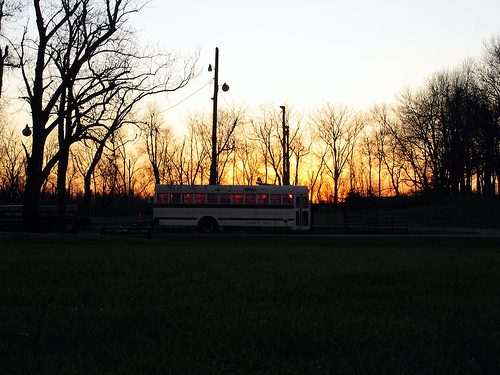
Light through windows of an Woodford County Park, Kentucky
(*photo
credit)
December 20, 2007 Wind and Populated Areas
Second only to existing renewable energy hydropower, one must
look at a Renewable America with windpower as a component of the
change that is needed by 2025. We must determine those areas with
higher wind potential (greater than four of a possible seven power
class) and within fifty miles of populated areas to reduce
transmission losses. Some dismiss wind power as more available to
the sparsely settled Great Plains. That is certainly true when
considering only land-based wind generation, for many of the wind
potential areas are of a lower power class especially in the
eastern portion of the Midwest. High potential land areas are
considered here (and also for solar and geothermal potential) from
maps currently available on a state-by-state basis from by the U.S.
Energy Information Administration.
A cursory observation of land-based wind potential often omits
the immediate off-shore potential of areas on the Atlantic coast
and the Great Lakes. Once these areas of high quality wind are
included, wind farms are possible off Cape Cod, the Delaware and
Jersey coasts, western Lake Michigan and parts of Lake Erie.
Therefore we have included immense populations of nearby
metropolitan centers such as Chicago, Boston, New York, and
Milwaukee. Suddenly the areas include about one-third of the
American people -- though the greatest opposition to exploiting
these high potential wind areas does not come from industry or the
general public, who would most likely prefer lower electricity
costs. They come from a select few who live near seashores and
desire their unobstructed views at whatever cost. Quite often,
these are liberal, affluent people who seek to be environmentally
correct on most issues but refuse to give up their viewscape.
Amazingly, this objection to off-shore wind farms has
virtually no ecological content as such, only the loss of a
privileged viewscape. But even this is a matter of taste for we
ought not to forget that Dutch windmills used to pump water from
the marshy land and to grind grain have been regarded for centuries
as an asset and a positive viewscape. Why could not the same occur
with our off-shore wind farms? They will not be near people who
might be disturbed by the swishing noise; they can have safeguards
to scare away most of the sea gulls or any birds that venture near;
they are too far off to fall and damage nearby housing in case of
falling apart in an unlikely wind storm.
The truth is that there is no reason why high quality wind
could not be utilized in all parts of our country. All that is
needed is a crash (Manhattan) program to furnish the equipment
needed to stock the wind farms -- the real bottleneck to wind's
rapid development at this time. With still better wind
technologies, one can expect that windpower will be extended to
lower grade wind potential areas of the Midwest and elsewhere.
That will undoubtedly occur in the time period from 2025 to 2050 if
not sooner. Meanwhile some lower potential wind utilization can be
expected to occur in the next few years.
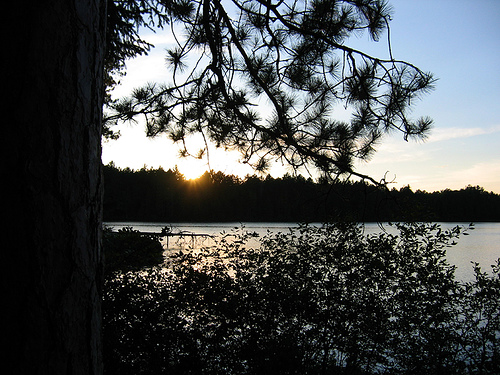
View from a water's edge
(*photo
credit)
December 21, 2007 High Potential Solar Areas
The sun shines on all parts of this country and world, but the
amount of "insolation" (the radiation from the sun received by a
surface) varies. The duration of sunshine in given days and
through given seasons may differ according to the territory. Of
course, to say that the southwest has the "best" solar potential is
a general statement with a number of qualifying factors. A given
area or sub-area may be within a shadow of a mountain during the
midday sunlight; a coastal area may be prone to fogs and the air
currents may be such that the fogs are slow at lifting. In saying
that an area has high or low solar potential (as with wind) we must
consider the particular micro-climate.
The U.S. Energy Information Administration has mapped out
portions of our country where the solar potential is greater than
6.0 kilowatt hours per square meter per day. We seek to take this
into consideration in planning for a Renewable America. We are not
saying that solar alone should be considered only for areas of high
potential, but that a priority be given in the populated areas
within those fortunate territories. Solar application should
continue to be encouraged throughout the United States, even in
areas with lower solar potential. As prices are reduced through
new technical innovations, the areas of practical application grow
and the price of the electricity generated declines. In the next
few years and before 2025 many individual homes and businesses in
lower solar potential areas will adapt solar technologies.
On a state-by-state basis, the region where the solar
potential is highest is for the greater part in the southwest
(southern California, Nevada, Utah, Arizona, Colorado, New Mexico
and western Texas). Small parts of the Oklahoma panhandle as well
as sections of Wyoming and western Kansas are included in these
high potential solar areas. In several states where the total
renewable potential coming from the four listed categories amounts
to virtually all the energy use, we make an effort to apportion
renewable energy percentages to the affected population according
to relative wind, solar, geothermal, and hydropower potentials.
Here in the first phase (2008-25) we seek to concentrate on solar
farms and establishments in high solar potential areas. Thanks to
the large population of southern California about one-ninth of our
nation's population lives within fifty miles of such solar zones
where greater economies are possible.
-------------------------
High Quality Solar* --
AZ (63%), CA (60%), CO (5%), KS (3%), NV (22%), NM (65%),
OK (1%), TX (10%), UT (5%), WY (2%)
Estimated total: 33 million
------------------------
* Percentages of state populations that could concentrate on
high potential solar (photovoltaic) applications in this first
phase of creating Renewable America (2008-25).
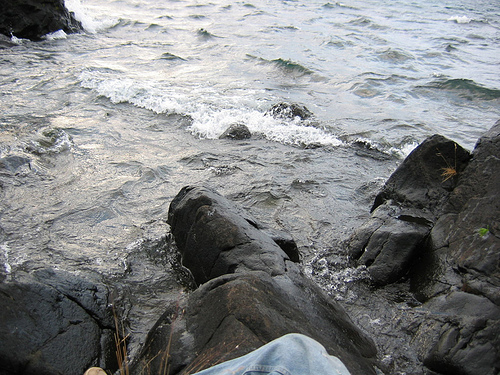
Reflection
(*photo
credit)
December 22, 2007 High Potential Geothermal Areas
We continue our explanation of the composite map of Renewable
America by looking at the last of four major areas (omitting
biofuels which make minor and transitory contributions). The
fourth area is high potential geothermal that can be used in
electric-generating powerplants as steam or hydrothermal fluids,
by direct use (commercial greenhouses, food processing facilities
or mining operations), or in geothermal heat pumps that are a
widely popular technology in many parts of this country. The heat
source of all these applications is naturally generated from within
the earth and concentrated for application; yes, no fossil fuel.
Our purpose here is to speak of massive electricity generation
projects that omit fossil fuel and nuclear power while encouraging
the continued application of the existing popular practice of
applying geothermal technologies at the individual homeowner and
business level (heat pumps, etc.). This high potential geothermal
strategy for the first phase (2008-2025) works in tandem with
solar, wind and hydro power applications introduced this week.
The U.S. Energy Information Administration has mapped the
nation as to higher geothermal potential using the following:
thermal conductivity, thickness of sedimentary rock, geothermal
gradient, heat flow, and surface temperature. When these factors
are considered in the continental United States and Hawaii, we find
most of the high potential areas (more than 80 milliwatts per
square meter) to be in our western states along with western Texas
and south central South Dakota. Some small high potential areas
are indicated in other U.S. Department of Energy data (Geological
Technologies Program) in the lower Mississippi valley as well.
Nevada and western Oregon and southern Idaho along with central
Colorado and New Mexico are covered by high potential zones but
these areas are rather thinly populated. The combination of
population and potential locations is found best in California;
here high potential geothermal energy is already being applied on
a commercial scale. Some of these areas are quite near highly
populated parts of coastal California.
------------------------
Geothermal accessible --
AK (3%), Ar (4%), AZ (3%), CA (12%), CO (5%), HI (15%), ID
(19%), LO (4%), MT (5%), NV (25%), NM (14%), OR (15%), SD
(5%), UT (13%), WA (7%), WY (4%)
Estimated total: 8 million
-------------------------
* Percentages of state populations who could concentrate on
high potential geothermal applications for generation of
electricity in phase one of Renewable America (2008-25). In
reality much of the United States has some geothermal potential and
as the technology develops over the coming years, these areas will
be increasingly available for energy utilization.

Bear Glacier Panorama / near Stewart, British Columbia, Canada
(*photo
credit)
December 23, 2007 Joseph's Dilemma
He was a righteous man... (Matthew 1:19)
The story that we read on this fourth Sunday of
Advent tells of an unusual dilemma for Joseph -- to understand Mary
and her condition and still do the right thing. Joseph trusted in
the Lord and also had confidence in the Virgin Mary to whom he was
betrothed. He could not understand how she got into her condition
and simply did not know what to do. To expose her before the
hostile public would mean her very honor and even life could be
threatened. His righteousness was like a cloak that covered his
entire being. He must do what is right and yet that is not always
so apparent even to the best of people. In that fitful dream the
angel or good spirit comes and tells him, "Do not to be afraid to
take Mary your wife into your home." Joseph does that very thing
and thus offers protection for her along with the knowledge that
this is a work of the Holy Spirit, which Joseph does not
understand. This agitation and resolution is part of the simple
Christmas narrative that we all know so well, and Joseph is in the
middle of the scene -- though Mary is the parent of the Savior.
Individual dilemmas. Things happen that we do not expect. We
get into circumstances that are not easy to resolve but we are
called to trust in the Lord. Our personal dilemmas are of great
importance and equally great disturbance; and often these dilemmas
require rather rapid resolution. What exactly should we do with
the limits on time, energy, money and talent? If we do this,
something drastic will occur. And then if we fail to act,
something else may happen as well. The challenge is to trust in
God and the resolution that will surely come will be an opportunity
for us to grow in faith.
Social and broader dilemmas. This can go beyond the rare
individual dilemmas and embrace our troubled Earth. What about the
innocent people who enter our ever-broadening horizon and who have
the need for protection and care? Can we handle such situations
given the demands on our own individual lives? How will we ever
get the addicted consumers of resources to step back, deny
themselves and radically share resources with the destitute and
underprivileged?
The complete Christmas story of a babe who is savior and
Emmanuel involves dilemmas; so does the coming of Christ to his
own today in this troubled world. Like Joseph, we must be
attentive and listen to the voice of the good Spirit with an open
mind and heart. While the path is difficult, we must welcome the
innocents into our home (our own privileged world), protect them
from harm, treat them as our own, free them from poverty and
insecurities, and help them to live an untroubled life. We are
able with the help of God to resolve the dilemmas facing us; we
are mere servants for everything is possible with God. Like
Joseph, we are eager to find solutions and, like him, we will
hasten to put these into effect through giving up, sharing and
defending the more helpless members of our human family.
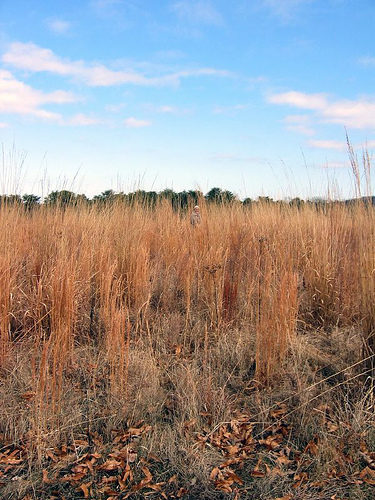
Prairie tall grasses in winter
(*photo
credit)
December 24, 2007 Make America Energy Renewable
Christmas even should be a time to resolve to renew ourselves
through broad-based citizen action. This will demand both
individuals becoming more conservation-conscious and their exerting
pressure on elected officials to promote an Apollo-type project to
bring America to the totally renewable stage. Both individual and
group actions must proceed simultaneously because we must check
resource growth through conservation and non-renewable resource use
through efforts listed earlier this month. The following are
actions we should consider for making these aspirations part of our
2008 actions:
* Install compact fluorescent lighting in more areas of the
home so that lighting expenditures on energy will be reduced.
* Use the automobile less and only while performing several
tasks at the same time to save on trips. Plan a vacation closer to
home or use less energy in the mode of the trip.
* Eat lower on the resource food chain by consuming less meat
and other animal products as well as carbonated drinks and prepared
foods.
* Raise temperatures in summer and cool naturally where
possible, and lower temperatures in winter and use warmer clothing
indoors.
* Consider installing more efficient appliances and reduce the
use of unnecessary gadgets.
* Reuse and recycle more often.
* Conserve on water use even in rainy times of the year.
* Acquaint yourself with the latest in renewable energy ideas
and innovations.
* Vote for green candidates and hold them accountable for
their conservation promises.
* Demand that more money be given to groups that seek to
develop renewable energy projects and place them on a par with
those projects that focus on longer-term research.
* Ensure that production of biofuels as alternative fuels
(alcohol) does not crowd out corn production for food needs.
* Demand that precious resources not be shunted to new nuclear
power projects as though this source of electricity is a viable
alternative to carbon-based fuels.
* Work for local renewable energy demonstration projects.
And have a merry Christmas!

A homemade, vintage Christmas wreath
(*photo
credit)
December 25, 2007 Christmas Dawning
See, the Lord proclaims to the ends of the Earth:
Say to daughter Zion, your Savior comes.
Here is his reward with him, his recompense before him.
They shall be called the holy people, the redeemed of the
Lord,
And you shall be called "Frequented," a city that is not
forsaken. (Isaiah 62:11-12)
In our troubled world we again seek the peace of the Lord this
Christmas. We sometimes forget the feast is tucked in between Mary
and Joseph's frantic look for a place to rest because of the coming
of their child into the world and their frantic effort to flee with
that child to Egypt to go beyond the reaches of a terrorist king.
It was a moment of time just as this Christmas is a moment of time
between the horrors of the past and the expected troubles of our
foreboding future, when poverty may spread, and suffering through
climate change will affect billions of people.
Christmas represents one of those moments of hope in the year
when we step back from those past and future dark clouds and we
pause for an ever so brief moment to hear the songs of angels in
the pure light of a promised Messiah coming among his own. For one
short span of time a new born infant gives us the hope that things
can be better, that the world can escape the tyranny of a divided
world of haves and have-nots, and that true peace can be in the
offing. Christmas is Christ, and Christ is light, and light is the
illumination to a more just world, and justice is a promise of what
lies ahead whether in our near-term age or in one to come later.
The promise is partly fulfilled in Christ's coming, which we
celebrate today. The fulfillment cries for us to participate in
our own way. We should pause but not stand too long before the
innocent babe in a crib; we adore but we are more than mere
spectators at a scene. Through our baptism/confirmation we are
other christs to the world; we are the bearers of the promises of
old to an anxious world; we are the ones who bring the Good News
to all creation. Zion is to be frequented by the message we have
to bring to her. We empower others through the exercise of the
power we have received through the graces of the sacraments -- and
we cannot hide them under a bushel basket. Christmas is ours to
receive; it is likewise ours to give.
Christmas always dawns in new ways. In this troubled world,
Christmas dawns in the town of Bethlehem but the dawn is globalized
for it goes far beyond a particular place. It goes to all people
of good will, and the hope is there that it will be fully picked up
as the light rays of a new day. They are out there looking for the
clear light of truth, and Truth has surely come on his own. This
world is better off because that dawn has come again and Jesus
Christ is among us once more in the freshness of a new-born babe in
a stable with the animals all around in adoration. But we take
this Good News beyond -- and that makes for a real Christmas.
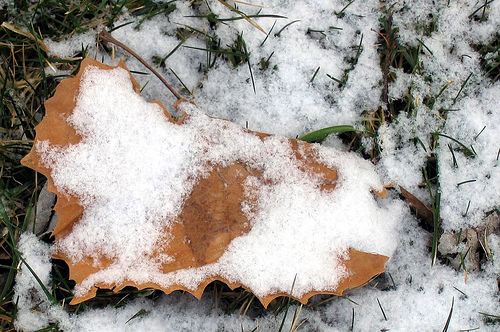
A dried American Sycamore, Platanus occidentalis, leaf,
covered with snow
(*photo
credit)
December 26, 2007 Fourth World Movement
Earlier this month (December 4) we looked at the poor as to
whether they are the seat of a problem or an integral part of the
solution of world problems. It has been our contention that the
poor are not to be only recipients of others gifts; rather they
are to be co-partners in making the world a better place. Here we
actually look at one group worth featuring for this month that is
addressing this issue in a gentle and public manner -- the Fourth
World Movement (FWM).
FWM is a Maryland-based network of people in poverty and those
from other backgrounds who work in partnership towards overcoming
the exclusion and injustice of persistent poverty. FWM says that
its projects focus on the sharing of knowledge among people of
different backgrounds in an atmosphere of mutual respect and
dignity. They try to reach out and create forums where the voice
and experience of those in poverty can influence public opinion and
policy. FWM has a corps of full-time, long-term volunteers who
spearhead this work, but they also rely on their members from all
walks of life to assist in their work.
FWM is a part of the International Movement ATD Fourth World,
which is a non-governmental organization dedicated to overcoming
extreme poverty throughout the world. It was founded in France in
1957 by Joseph Wresinski (1917-88) who grew up in poverty himself.
He also founded the Tapori Children's Network to further friendship
among children from different social backgrounds as a way of
fighting chronic poverty. Today this international movement has a
full-time volunteer corps with teams in twenty-five countries and
correspondents in ninety, actively involving some 100,000 people
throughout the world. As a non-governmental organization (NGO), it
has general consultative status with the United Nations.
The movement came to the United States in 1964 to work on the
Lower East Side of New York City. It expanded into Appalachia
(Virginia), and New Orleans especially since the Katrina Hurricane.
The FWM headquarters is in the Washington, DC, area.
Fourth World Movement
734 15th Street, N.W., #525
Washington, DC 20005
(202) 393-2822
7600 Willow Hill Drive
Landover, MD 20785
(301) 336-9489
<www.national center@4th worldmovement.org>
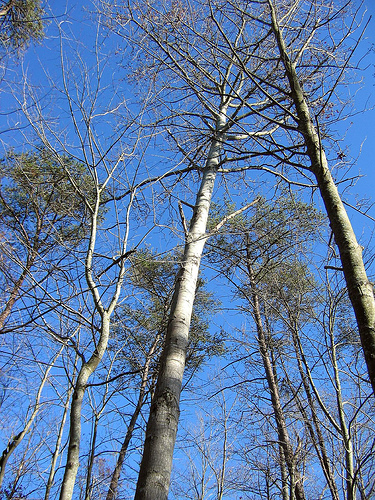
Bigtooth Aspen, Populus grandidentata, standing leafless.
Daniel Boone National Forest, Wolfe Co., Kentucky
(*photo
credit)
December 27, 2007
God Only Knows
Billions of years preparing
for this last moment in geologic time.
Out into the icy darkness of the universe
beat warm hearts of living creatures.
In random fashion, flora and fauna evolved,
each nodding its "yes" to the Creator.
Finally came the final second of time
when Adam and Eve shared forbidden fruit.
They forgot that Heaven and Earth did intertwine,
God walking with them among shaded vine.
They, with divine gift of freedom to affirm,
instead from Eden uttered a resounding "no."
Divine presence sought, and loving mercy spoke
through prophets a promised Messiah.
In the fullness of time God walks again
our savior, healer, teacher, friend.
Coming in soft-lighted liturgical setting
and fulfilling the incarnate word, "Christ-mass."
God's loving mercy is in that walk with us,
and we, in original form, have tasted fruit
in our Tree of Knowledge of Good and Evil --
Nuclear powerplant, ripe for terrorist plots.
Will we say "yes" to God and dismantle these
weapons of mass destruction in our midst?
God only knows!
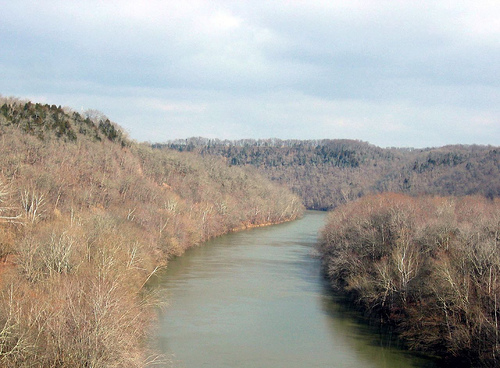
Looking down upon the Kentucky River
(*photo
credit)
December 28, 2007 Holy Innocents Day
A voice was heard in Ramah, sobbing and loudly lamenting;
it was Rachel weeping for her children, refusing to be
comforted because they were no more. (Matthew 2:18)
This Gospel quotation pertains to the massacre of the babes of
Bethlehem that was ordered by Herod in an attempt to include Jesus
in this sweep of the town. Certainly Jesus' early life got off to
a rather rough start through an escape from a mass killing. The
other infants had shortened lives -- as occurred at other times in
the cruel portions of human history -- in times of war and famine
and disease. And pro-life folks are quick to point out the
application of the verse to the practice of abortion. Let us take
this a step farther while not dwelling further on any of the cruel
incidents as such. Let us seek to make such cruelty in all its
forms more rare if not non-existent.
Today innocent infants are those who die before the age of
five from lack of proper nutrition or preventable health practices
such as vaccination. Though we cannot determine exact number
counts, we are perhaps speaking of three thousand children a day or
a million a year; some say the figures are much higher (see UNICEF
on 7/31/07). Whatever the total count, there are far too many of
the twenty-first century holy innocents.
A concerted effort to save the children who suffer from
malnutrition and preventable disease is needed today, for far too
much is being spent for luxury items and for unnecessary military
expenditures. The failure to assist the efforts to protect human
life in the early stages after conception and up to five years
works against the human race and cheapens life itself. As we
mention elsewhere, people (parents, etc.), who are helpless before
violence done to a fetus or an infant in whatever manner that
shortens life, are victims of terror and experience its effects all
their mortal lives. This says nothing about the victim who has a
life shortened, the failure to reach the fullness of what this
resource-filled planet could offer all its inhabitants. Rather it
continues so much of the same, a world of a selfish few crowding
out the innocent and underprivileged.
This feast day (if we could call it such) reminds us once more
that innocent infants suffer for the wrongdoing of us all. We may
not be the ones who are cruel Herods, but we allow this suffering
to exist by not exerting ourselves to help save the lives of the
sick and starving. Thus we disrespect all human life and weaken
the threads of that precious web of life. If and when we feed the
hungry and give those small additions of support to struggling
governments in Africa to provide primary care to infants, we
enhance that respect for all life for we are all brothers and
sisters of one human family. And infants who are frequent victims
are the voiceless ones. On this day we recall those who had their
life snuffed out by deliberate actions or calloused omissions.
They certainly are part of this Christmas season.
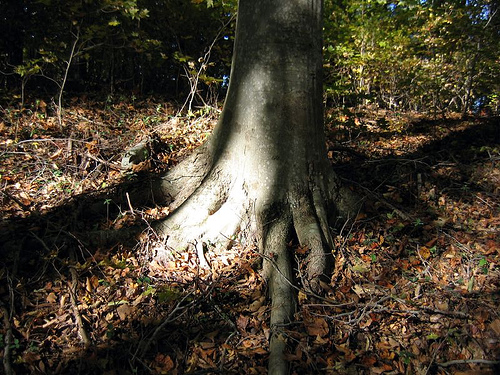
The trunk of an American beech, Fagus grandifolia
(*photo
credit)
December 29, 2007 Civility and Courtesy
Rule 6: Sleep not when others speak. Sit not when others
stand. Speak not when you should hold your peace. Walk not on
when others stop. George Washington's Rules of Civility (1744),
ed. Alan Haslett (New York: Akashic Books, 2004).
As the year comes to an end, it is wise to review our lives
and our sense of reverence for all. This is a good time within the
twelve days of Christmas and before we launch into a New Year.
How were our practices of civility and courtesy in relation to
others during 2007? What about abrupt e-mails? Laughing at cruel
jokes or foul-sounding talk shows? What about rude driving habits
on the road? Do we still respect -- our past, our family life, our
neighbors, our religious practice, our state and nation and the
leaders, our environment, the political process, commercial and
professional advice, and our elders and wise folks? Is it possible
that we have allowed the erosion of respect through silence when we
should have spoken, through our own haste and lack of manners, or
through pranks, jokes, back-biting, unresolved disputes and
cynicism? Has our sense of courteous respect wasted away, or was
it ever there? Does it fade or erode imperceptibly through
commercialism, wars, legalizing abortion, crass exploitation of the
land, and the ever expanding gulf between the rich and poor? What
about MTV, ready cash through credit cards, talk about rights alone
instead of rights and responsibilities, and lack of giving space to
silence and reflection?
The good old days? Maybe we were respectful in the past, but
that may be quite romantic hindsight. In its early days, Americans
were a homesteading, non-religious and sometimes cruel lot.
Whatever the past in its entirety, we get clues that there were
specific traces of today's lack of reverence for life, country,
resources, land, or for leaders at every level. "I for me" reaches
into our past history and can play havoc to any common atmosphere
of respect. But looking back we find that to pay respects to
someone who is sick or to the bereaved is an age old custom. To
pause when the funeral passes is a fading practice. To welcome
people into a community, to offer a seat to an elderly person, or
to send get well cards are expressions of respect from our past.
Why is respect eroding? Is it a decadence in our culture? Is
it the break down of marriage, family, community and neighborhood,
all of which occur when respect for others fails? Is there a
championing of irreverence and informality in Hollywood and the
mass media? Must we awake and seek to return to reverence? Some
suggest that the breakdown in reverence extends both to the people
and to Earth herself -- broken down communities and broken down
biosystems as mountains are leveled, valleys filled, and the
vegetative cover stripped away to satisfy distant chipmills. If we
are persuaded to think our environs are worthless, we are being
lulled into silence when the destruction proceeds. When crass
commercials bombard us with the irrelevant and the sensual,
reverence fades.
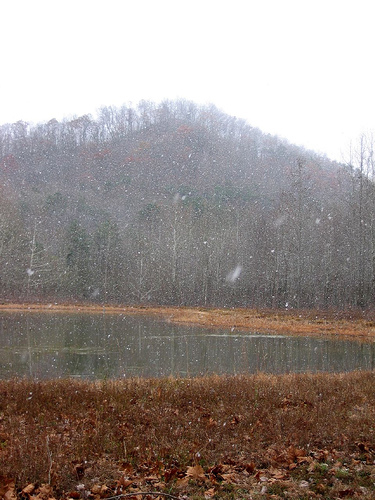
Snow squall in the Knobs region of Kentucky. Madison County
(*photo
credit)
December 30, 2007 Extended Families
When we read in today's Gospel from St. Matthew's Gospel about
the flight into Egypt, we are reminded of the millions of people
who are disassociated from their extended families through economic
or political migration or through temporary emergencies. The
refugee and the migrant are close to our minds and hearts on this
feast of the Holy Family that is squeezed into the Christmas
holidays between Christmas and New Years.
During this holiday season "family" time we need to give
special attention to all who may wish a little better social
connection with established families. First our own extended
families always need further bonding.
* Send a belated card if you learn late of the death of a
close relation of one of your extended family members. Or maybe
the problem is that we simply have overlooked someone in the course
of the first greeting round and it is still time during the second
portion of the Christmas season. Better late than never.
* Email, phone or visit a distant cousin or relative that you
have heard has had a major problem with health, has had one of his
or her own move away, or has moved to a new place. The
communication helps in so many ways.
* Extend the same concern to neighbors or friends who have
lost the loved one, who have been ill, or who have had some mishap.
Our thoughtfulness is highly valued.
* Invite someone who has just moved in to a social or
religious event in your community so that you may be regarded as
part of their family away from home.
* Attempt the difficult task of securing a reconciliation
among family members. The family that does not have estranged
members is rare and so rebinding these members to each other will
be a most happy occasion. Often this may not be received well but
it is worth the risk.
* Review the folks in your own life and ask on this feast of
the Holy Family who would like to be contacted. Should you think
about a family reunion for 2008? Should there be some effort to
develop a family tree or address listing that others in the
extended family might find useful.
* This is a time to thank God for the various members of that
extended family that makes each of us who we are. Review the cards
and the photos that come during the holidays and decide to make a
bulletin board or display on which the family photos will be shown.
When you come home look again at the photos and say a small prayer
for each family member displayed. It is all part of binding the
ties all the tighter. Why can't we do this before the next funeral
that inevitably brings us together?
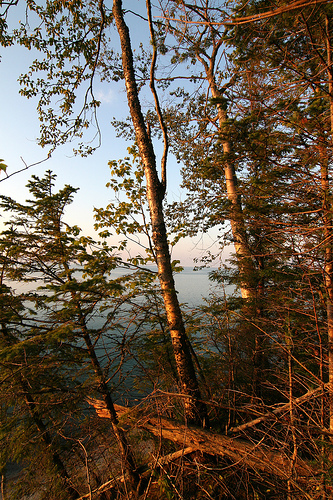
Warm hues of the evening alpenglow in the forest.
The sun sets on 2007.
(*photo
credit)
December 31, 2007 Final Blessings
We have received countless blessings through 2007. In several
of the daily reflections we have attempted to count them and show
our gratitude to the Giver of all gifts. Remembering blessings
given to us and their Source is a blessing in itself. But this
current reflection is somewhat different. It pertains to our
giving blessings, something that any of us can do. If we are so
blessed, we too must bless others. These are the final ones for
2007 -- and should be regarded as though they are the final ones in
life itself. By instilling a finality to our own act of blessing
we enter it more whole-heartedly -- much like a parent who gives
children a final blessing before they pass on from this life. For
we are the parents of our time; our efforts are the offspring that
need our good will to nourish and flourish.
Some of us are empowered to give special blessings, whether by
our station in life (e.g., as parents), or elected position, our
specific calling, or our ordination. Others of us see that we can
give blessings for we find in Scripture that we can "bless God" --
and all of us can do that. It seems that we make our lives a
blessing by giving, not by receiving. While we can say, "I am
blessed," we can also say with equal enthusiasm that "I bless."
What makes us more of who we are is what we give generously and
wholeheartedly. Certainly we received first our life, but in some
way the blessings we give actually enliven life itself.
There is no neutrality when it comes to blessings. We can
withhold a blessing for some reason or other, maybe even quite
legitimate ones. Or even more negatively we can curse others or
call down evil on them. Whether curses or blessing, these are all
part of the reality in which we live. Yes, if a blessing is not
received, it will return to the giver as Scripture says. Our
entire life should certainly not be one of cursing and only rarely
that of holding back a blessing that we would give or receive. The
Spirit inspires us to give out blessings, to spread the Good News.
We are drawn at the end of 2007 to see this blessing on all
who read these words as a final blessing -- a solemn wish that you
will have a new year that is even more blessed than the last one.
But this is meant also to bless jointly with you in extending good
will to all on this planet, especially to all who seek to help heal
our wounded Earth. This is a solemn moment in our troubled Earth.
We can heal and bless together and thus give greater power to the
reality of extending God's goodness to all creation. What we are
called to do in association with each other is to realize how we
are blessed and how we are empowered to bless. We do not rest on
that empowerment whether parent or priest or leader or professional
or worker. Rather we are empowered to bless so that they can bless
all the more -- and this gives more meaning to what we do and
certainly more to what all the healers of the Earth can do. So let
us together make this a final blessing to all on these final
moments of New Year's eve. |